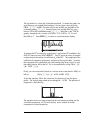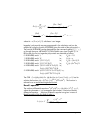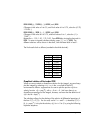
Page 16-52
where M = n/2 or (n-1)/2, whichever is an integer.
Legendre’s polynomials are pre-programmed in the calculator and can be
recalled by using the function LEGENDRE given the order of the polynomial, n.
The function LEGENDRE can be obtained from the command catalog (‚N)
or through the menu ARITHMETIC/POLYNOMIAL menu (see Chapter 5). In
RPN mode, the first six Legendre polynomials are obtained as follows:
0 LEGENDRE, result: 1, i.e., P
0
(x) = 1.0.
1 LEGENDRE, result: ‘X’, i.e., P
1
(x) = x.
2 LEGENDRE, result: ‘(3*X^2-1)/2’, i.e., P
2
(x) = (3x
2
-1)/2.
3 LEGENDRE, result: ‘(5*X^3-3*X)/2’, i.e., P
3
(x) =(5x
3
-3x)/2.
4 LEGENDRE, result: ‘(35*X^4-30*X^2+3)/8’, i.e.,
P
4
(x) =(35x
4
-30x
2
+3)/8.
5 LEGENDRE, result: ‘(63*X^5-70*X^3+15*X)/8’, i.e.,
P
5
(x) =(63x
5
-70x
3
+15x)/8.
The ODE (1-x
2
)⋅(d
2
y/dx
2
)-2⋅x⋅ (dy/dx)+[n⋅ (n+1)-m
2
/(1-x
2
)] ⋅y = 0, has for
solution the function y(x) = P
n
m
(x)= (1-x
2
)
m/2
⋅(d
m
Pn/dx
m
). This function is
referred to as an associated Legendre function
.
Bessel’s equation
The ordinary differential equation x
2
⋅(d
2
y/dx
2
) + x⋅ (dy/dx)+ (x
2
-ν
2
) ⋅y = 0,
where the parameter ν is a nonnegative real number, is known as Bessel’s
differential equation. Solutions to Bessel’s equation are given in terms of
Bessel functions of the first kind of order
ν:
mn
M
m
n
m
n
x
mnmnm
mn
xP
2
0
)!2()!(!2
)!22(
)1()(
−
=
∑
⋅
−⋅−⋅⋅
−
⋅−=
.....
)!2()!1(!12
)!22(
)!(2
)!2(
2
2
−+⋅
−−⋅⋅
−
−⋅
⋅
=
−n
n
n
n
x
nn
n
x
n
n
∑
∞
=
+
++Γ⋅⋅
⋅−
⋅=
0
2
2
,
)1(!2
)1(
)(
m
m
mm
mm
x
xxJ
ν
ν
ν
ν


















